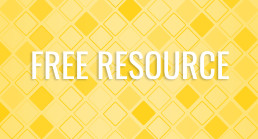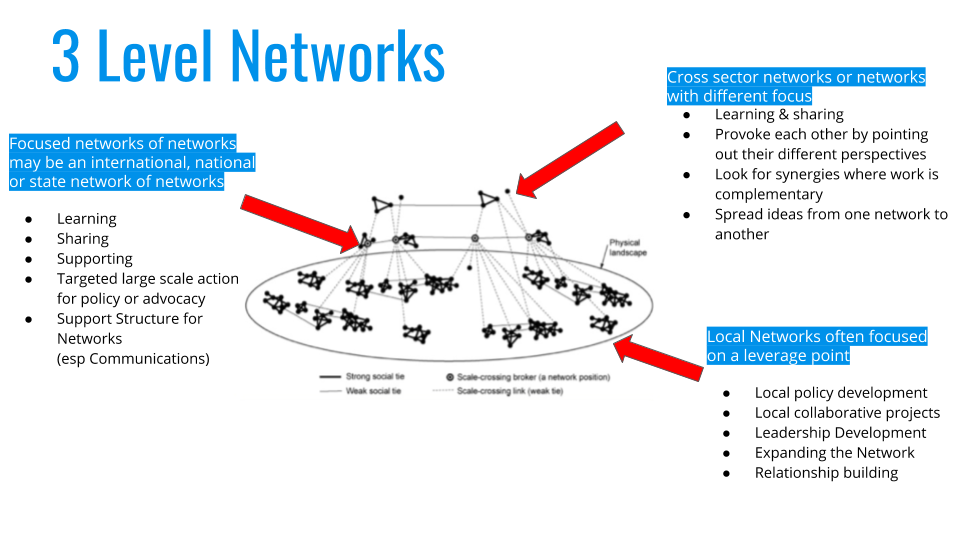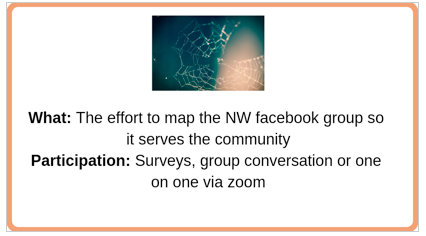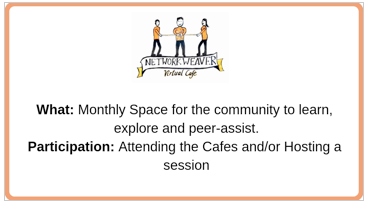Stipend for Posts by People of Color
We are offering a stipend of $250 for any relevant blog post or resource submitted by a Person of Color to help support hearing all voices on our blog. You can submit up to 4 blog posts or resources during the year.
Simply write a blog post of around 250-750 words (1 to 3 pages) about anything that can advance our network strategies. We are especially looking for articles on how people are or could be collaborating to dismantle racism, but all topics will be considered.
If you have any processes, worksheets, handouts that you have used successfully, please consider submitting them as well! If you want to charge for them, let us know as we want to experiment with having payment paid directly into your PayPal account.
Here is the process:
- Send your draft or paragraph of your topic to June for approval at: info@dev.networkweaver.com. [ap_spacing spacing_height="10px"]
- If approved, submit your blog post or resource as a google doc, or if you don’t use google docs, a word doc. [ap_spacing spacing_height="10px"]
- Include a mailing address for your check to be sent to, a photo of yourself and a 1-3 sentence bio which will appear in the post or resource.[ap_spacing spacing_height="10px"]
- As soon as it is approved you will receive the check, although it may take a few weeks for the blog or resource to be posted.[ap_spacing spacing_height="10px"]
We look forward to receiving your submission!
Featured image found at hbr.org
Transformational Weaving In The New Year and Decade
[ap_spacing spacing_height="15px"]
2020 is not only a new year, but the beginning of a new decade.
I’ve pulled together some questions you might want to use to guide a deep reflection in preparation for the coming times.
I’ve come to see that the embracing of true peerness with all others is the core value that needs to be in place if networks are to become transformational. But we are each wrapped in a sticky, almost invisible cocoon of our culture - a culture that has taught us that we are separate from others and that every relationship has a hierarchy.
So the first question I ask for this new year: How can you begin the healing process that will enable you to remove the cocoon of dominant culture? How can you dismantle the hierarchy, patriarchy and racism all around us that keeps you and others from a life of wellbeing? How can you find others to work with you on this?
Because dismantling hierarchy is so core to the transformational aspect of networks, we here at Network Weaver are going to try to publish at least one blog post a month on this important topic. If you have some thoughts, an existing blog post or recommended resources on this topic, please send them our way!
[ap_spacing spacing_height="15px"]
The second question is: If you are an experienced network weaver, how can you become a mentor to less experienced weavers, especially those who come from communities of color or from the global south? If you are a novice weaver, how can you find and reach out to a more experienced weaver so that you can get the support and practice you need to more quickly become a skilled weaver?
[ap_spacing spacing_height="15px"]
The third question is: How can you share more of what you are learning with weavers around the world?
Can you write a blog post for your blog or the network weaver blog on on your work? Have you developed resources that you use in your network work and practice that you could share with others in the resources section of our site?
In 2020 we’re going to make the site able to handle payments to multiple product owners so you can generate some income from your materials. Can you please take a bit of extra time to document what you’re doing and share it with others? It’s this kind of learning and sharing that is going to bring transformation more quickly. As Curtis Ogden often reminds us, transformation is about changing the flows in networks and that is what your sharing can do.
[ap_spacing spacing_height="15px"]
The fourth question is: What networks do the networks you work with need to connect with to provoke their thinking and aggregate their efforts? How can you bring together participants from two or more networks to build the relationships that they will need to share and work together?
[ap_spacing spacing_height="15px"]
And one final question: How are you going to take care of yourself this year so you are in the best shape to do this weaving work? What can you do to work from a more centered and supported place where you can get the clarity you will need to ruthlessly prune your to do list and have the spaciousness to notice and engage when areas of opportunity arise?
[ap_spacing spacing_height="15px"]
What questions would you like us to focus on to be ready for the coming decade? Please share in the comments below!
[ap_spacing spacing_height="20px"]
Featured Image : Jan Tinneberg / Unsplash
Storytelling to Enable Systems Thinking
For a long time I developed models and inflicted them on other people. Fortunately, due to the interaction with others, it became apparent that it made more sense to become a storyteller of relationships and their implications.
This video offers thoughts on why it's not possible to sell systems thinking, or anything else to a person or an organization, and insights on how to offer the understanding of the benefits of shifting to systems thinking.
[ap_spacing spacing_height="20px"]
Who Decides?
In January, Nevada became the first state in the US to have women in the majority in the state legislature. This article from The Washington Post highlights how issues and bills are being debated that would “not have seen the light of day” in previous sessions: “Bills prioritizing women’s health and safety have soared to the top of the agenda. Mounting reports of sexual harassment have led one male lawmaker to resign. And policy debates long dominated by men, including prison reform and gun safety, are yielding to female voices.”
Having the people affected by decisions and policies participate in the debate and decision-making is a step forward. Tom Atlee of the Co-Intelligence Institute defined the original dream of democracy as “the participatory determination of our collective fate.”
Some of the core principles of social and racial equity are: Who decides? Who has a voice? What inputs and experiences inform the decisions being made? Centuries before us, people revolted against monarchies in which one person held concentrated power. We have been slowly evolving toward more democratic forms of governance and decision-making. It feels we are in a time of cross-currents, where there are innovations and breakthroughs in participatory process and governance, but there are still many rooms of power where decisions are made that don’t include participation and input of those affected. Plus, there are polarizing developments, extreme concentrations of wealth and power, and authoritarian actions that undermine democratic process.
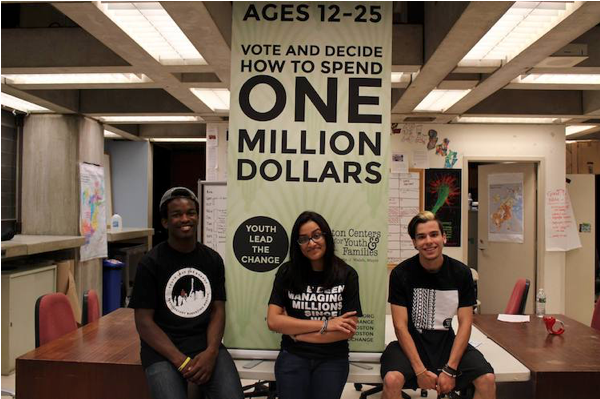
Evolving how we make collective decisions is imperative and will affect our ability to make sound decisions on many issues. This is a time to expand the practice of participation and good governance in decision-making, at every level. This applies in teams, organizations, coalitions, networks, philanthropy, and the political process.
Each issue is like a string connected to a web. We see the string and think the answers are simple and obvious. No one person can see all the areas where the string connects and affects other issues, people’s lives and the environment. When decision-making power is concentrated in the hands of a few, we are less likely to recognize and avoid unintended consequences. Diverse participation widens our collective view and understanding, and it is crucial to shifting patterns of systemic racism and oppression.
Politics tend to divide people into camps and force complex multi-faceted situations into falsely simple yes/no choices. Simplified “for or against” framings, driven by politics, are problematic. Brexit is a case in point. I appreciated this comment on a listserv right after the vote, and see now how prescient it was:
It’s a perfect example of not understanding how to think and make decisions in complex systems; the relationship(s) the UK has with EU is far more involved than even a hundred heads could hold, and it’s suffered a linear intervention reduced to two options of ‘In or Out’. Linear interventions into complex systems explode in your face.
It is critical to adopt approaches to making decisions and governance that are attuned to the complexity and inter-woven nature of the challenges we face and that are rooted in an ethic of care for the well being of everyone (not just those who voted for a particular candidate). Emerging innovations in governance demonstrate that people have the wisdom to come to wise decisions together. Here are a few examples of the bright spots of promise:
- Participatory budgeting – a public process that gives people the power to “decide together how to spend public money,” being used in communities around the world. Check out The Participatory Budgeting Project for more information. [ap_spacing spacing_height="10px"]
- vTaiwan – a breakthrough, self-organizing democratic process using on-line forums for building consensus and face-to-face live dialogues. Tom Atlee has written about it in this blog series and here are more links shared by Rosa Zubizarreta, who wrote “As I’ve been telling my friends, it’s good to know that something good is happening on the political level, somewhere in the world…” [ap_spacing spacing_height="10px"]
- A Framework for Inclusive Governance and Rural Planning from Sierra Leone, an integrated process of people’s led planning from the local to regional to national level. [ap_spacing spacing_height="10px"]
- In philanthropy, conversations on equity and “who decides?” are leading to new models of community-led grantmaking, where community members, particularly those from traditionally marginalized groups, play a more direct role in deciding where grant dollars flow. [ap_spacing spacing_height="10px"]
- In response to climate change, the Extinction Rebellion in the UK has 3 demands for government action. The third is to move beyond politics: “Government must create and be led by the decisions of a Citizens’ Assembly on climate and ecological justice.” See the Sortition Foundation for more information the process of citizens assemblies. They describe their work this way: “We campaign for a world free from partisan politicking, where representative random samples of everyday people make decisions in informed and deliberative citizens’ assemblies.” [ap_spacing spacing_height="10px"]
- Democracy R&D is a new global network of organizations helping decision makers make hard decisions and build public trust, while strengthening democracy. Check out the list of countries and organizations to see how many are working on ways to involve everyday people in public decisions. [ap_spacing spacing_height="10px"]
Originally published at New Directions Collaborative on May 30, 2019 by Beth Tener
SHIFTING A SYSTEM: The Reimagine Learning network and how to tackle persistent problems
[ap_spacing spacing_height="12px"]
Some problems are simply too big for any one organization. One solution: a network of like-minded leaders working toward a common goal. Reimagine Learning, taking on systemic education issues, offers a successful model.
[ap_spacing spacing_height="15px"]
In an increasingly complex business and social environment, many are looking for collective solutions to big problems. Networks can address sprawling issues in ways that no individual organization can, working toward innovative solutions that are able to scale.
Fortunately, the collective capacity to address persistent problems is deepening in real and exciting ways. A set of tools, processes, and mindset shifts has emerged to help leaders align a set of diverse actors around a shared understanding of a problem and then create a coordinated plan of attack.1 This approach to large-scale problem-solving is a powerful way to catalyze progress.
Our full-length report, Shifting a system, presents a case study of how a group of leaders and their organizations can coalesce behind a shared vision for change.
The Reimagine Learning network came together to tackle big education issues, ultimately aggregating and deploying US$38 million in philanthropic capital. Over six years, members worked to create teaching and learning environments aimed at helping to unleash creativity and potential in all students, including those who have been historically underserved. The group—launched with 32 members, now grown to more than 700—helped build and scale organizational models that embed a focus on both social emotional learning and learner diversity, ultimately funding 25 organizations that collectively serve 7 million students nationwide.
The experience of Reimagine Learning’s members suggests lessons about effective steps that leaders might take in constructing a network:
- Map the landscape. Reframe the problem. To broaden the aperture of possibility, bring unlikely bedfellows to the table.
- Understand differences. Discover similarities. To shift the status quo, imagine the future you want to create.
- Deepen strategies. Learn by doing. To make collective progress, embrace the intellectual humility of uncertainty.
- Move from curiosity to action. To deepen organizational capacity, nurture individual curiosity.
- Grow the group. Increase impact. To understand network impact, accept a broader definition of measurable value.
- Assess the whole thing and why it matters. To know where to go, assess where you’ve been.
[ap_spacing spacing_height="20px"]
Seeking systemic solutions
In 2012, when Reimagine Learning began forming, the US education system showed serious signs of struggle, with less than 40 percent of K–12 students proficient in math or reading and 1 million dropping out of school every year.2 Meanwhile, 12 million school-aged people had experienced three or more adverse childhood experiences, such as abuse, neglect, or household dysfunction, and 21 percent of all school-aged people lived in poverty.3
Leaders in education had formed well over 100,000 education nonprofits, aiming to address some of the issues, but the scope was simply too broad for any one organization to have a significant impact. In addition, even as a growing body of research highlighted the importance of supporting diverse learners—including students dealing with poverty-related trauma—educators, researchers, and advocates for students with learning and attention issues felt excluded from the general education-reform conversation.4
The Reimagine Learning network was launched to empower groups focused on learning differences, social emotional learning, and trauma. Catalyzed by Boston-based venture philanthropy organization New Profit and US$38 million of funding, this diverse network of change agents aimed to support an approach to education based on a deep understanding of how students learn.
Reimagine Learning’s goal was audacious and desperately needed: to fundamentally reimagine how learning happens for children in this country and to offer a new vision of how to meet the needs of a set of learners typically underserved by the education system. It was a call to action that galvanized people and organizations across the country to participate in a collaborative process to craft a vision and in a strategy to shift a system.
This six-year initiative demanded a major reframe in thinking about the role of education and how to make it more effective. And changing the mindset or paradigm out of which a system arises is one of the most powerful leverage points in a system you can affect.5 But gaining a hard-won mindset shift is only the first step in a journey. In the case of Reimagine Learning, getting to that point took years, and it was only the beginning of the process to get to action on the ground that would drive outcomes for young people and families. What followed was a series of changes—within and among individuals and organizations, in classrooms and boardrooms, at the dinner table and on the floor of the US Senate—that reflected this reimagining, allowing the effort to come one step closer to unleashing the potential of all students.
Participants’ involvement in shaping Reimagine Learning’s vision and strategy prompted them to reshape their own organizations, which collectively serve 7 million students nationwide.6 At its core, engagement in the network succeeded in changing the mindsets of many of its participants, who in turn influenced practices in school districts across the country and created a deeper understanding of what supports a “whole child’s” learning in a classroom.
[ap_spacing spacing_height="20px"]
Stronger together
Obviously, not every organization—or organizational goal—is best served by developing and engaging in a network. It’s a mode of problem-solving that asks leaders to assume a network mindset and demonstrate a willingness to work with and through others.
Ultimately, working in a network requires the integration of three key dimensions: an understanding of human dynamics—the people you need to build solutions and make them stick; an ability to craft collective strategy—getting smart about the problem and developing a point of view and action plan; and developing the right network configuration—designing and weaving a different kind of structure to support a group as it forges its own path forward.
It is a way of working that defies command-and-control posturing, in which insights come from the collective—and connections among them—rather than experts. It’s a journey on which there are no short cuts, and it will try the patience of those tied to short-termism. Yet it is an approach to problem-solving that we hope continues to be tested and developed.
See our full-length report, Shifting a system—a case study developed by the Monitor Institute by Deloitte in collaboration with New Profit—for a full account of how Reimagine Learning’s members came together to accomplish real change.
[ap_spacing spacing_height="15px"]
Originally published 4/29/19 at Deloitte Insights by Anna Muoio and Kaitlin Terry Canver
[ap_spacing spacing_height="20px"]
3 Level Networks
[ap_spacing spacing_height="20px"]
Networks of networks have huge potential. They encourage the kinds of aggregation and numbers that can result in successful campaigns and policy initiatives.
They also can convene innovative projects from around the country (or world) to learn from each other, support each other and provoke each other to expand how they think about what they are working on.
Transformation or system shifting requires networks to be involved in networks of networks. This diagram and activity is designed to help networks develop networks of networks to maximize their impact.
CLICK HERE to access the 3 Level Networks download.
[ap_spacing spacing_height="20px"]
The Transformative Power of Networks of Networks
Three Level Networks for Transformation
I’ve mentioned before that transformation or system shifting requires networks to be involved in networks of networks. This blog post will explain why every network needs to be part of and explicitly develop networks of networks to maximize their impact.
Networks need to be part of three types of networks, shown in the drawing below.
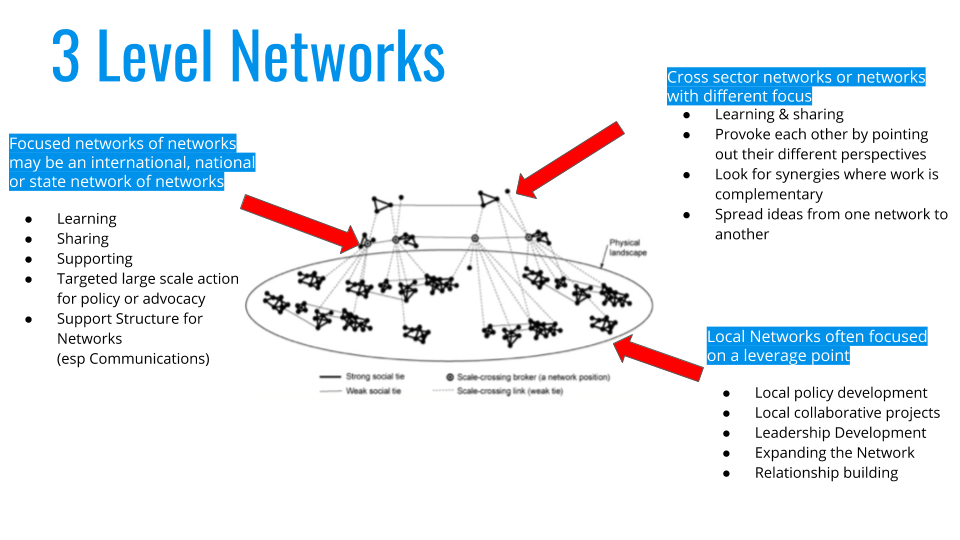
1. Local Networks
Local networks are networks formed in a particular locale, usually a city, town or in rural areas or a multi-county region.
Often local networks focus on a particular issue area, problem or alternative. Examples range from local food networks and local culture of health networks, to local climate change networks. Although a network may be catalyzed as part of a national effort (Robert Wood Johnson Foundation’s culture of health efforts, for example), it’s local roots in a set of specific local communities is critical for success.
Local networks are where small but concrete collaborative projects can be nurtured, and where residents can build new leadership skills as network weavers. Each local project is an opportunity to invite in new people and thus expand and diversify the network.
Local networks can also be very effective in advocacy and in policy work. For example, many local food policy councils are writing the food section of local sustainability plans (which city councils are approving with few or no changes).
Many local communities have informal networks, especially among nonprofits. Their staff probably know each other and may collaborate on the occasional project. But any community can become much more effective by making their local network more intentional.
This usually means:
- convening not only area nonprofits, but including government officials and agencies, businesses, and residents
- determining a purpose for the network which is essential to help focus collaborative efforts
- Identifying leverage points where change is more likely to occur
- forming work groups to collaborate around those leverage point
2. Focused Networks
Focused networks are networks, often national (though they may be state, multi-state or international), that focus on a particular issue, problem or alternative.
Often these are branded networks (have a specific name i.e. 350.org rather than environmental network) whose participants are individuals, organizations or local networks. So, for example, the Center for a Livable Future at Johns Hopkins has helped build a national network of local and state food policy councils. They have a lively listserv for sharing information and discussion, and frequent webinars and videoconferences.
Not all focused networks help foster local networks, but when they do, they gain access to lots of innovation and usually find that this strategy enables them to rapidly expand their national network. In addition, when national networks convene local networks, local networks can learn about the innovations happening in other communities and adapt those successes in their networks. So instead of simply focusing on individual local leaders, as many focused networks do, they could encourage and support the local leaders to form local networks. Center for a Livable Future did this by having a series of virtual sessions on how to create local food system networks.
Funders could amplify this catalytic and convening role for national networks by providing funds for Innovation Funds. Summer Matters, a network of summer programs for children, for example, set up an Innovation Fund to encourage their local members to form collaborative projects in their local community. When Innovation Fund projects are convened virtually, they can better capture breakouts and innovations to share with the larger network. In addition, the funded groups form a peer support network which generally last beyond the funded period.
I’d love to hear stories of focused networks that proactively helped local networks form...please share your experience in the comments below.
Focused networks are often able to mobilize large numbers of people and/or organizations to do advocacy or actions, or conduct policy initiatives. However, if they do these in a self-organizing fashion, i.e. encouraging people to work with others on posters for marches or for visits to legislators, and at the same time provide tools and encouragement to continue self-organizing when they return home, they can greatly increase their impact.
3. Networks With Other Networks
Networks can really benefit when they network with other networks. These types of networks help networks be transformative either through their differences or through their power of aggregation..
However, this type of network is most likely to be neglected. These networks can be one of three different kinds:
- networks of networks with a similar focus formed to create the numbers needed for effective large actions
- cross sector networks
- networks that are quite different in purpose but can be constructively provocative for each other and stretch everyone’s world views
Aggregated networks are composed of branded networks that are working on a similar focal area - for example environmental and climate change - who can work together, especially on large-scale actions and campaigns or on policy initiatives, to have much greater chance of serious impact than could result from a single network’s action.
Most of these networks are loosely linked to others like themselves but few have explicitly met to discuss ways they can share information or identify emergent opportunity areas where they might work together. Many aggregated networks are formed for marches, such as the 2014 climate change march in New York City. However, like this one which was orchestrated by a single organization (350.org), the network brought together by this march was short lived.
We strongly encourage national networks to begin reaching out to other related networks and meet as peers not just on joint marches and actions, but to understand the system they are trying to change, determine who is working on what, and figure out how they might have some protocols for sharing information and have convenings to share what each is learning.
This is something I’m particularly interested in working on, so if you are too, get in touch with me at juneholley at gmail.
Cross sector network of networks are when a network invites in or networks with entities or networks from different sectors. For example, a local food network might create a larger network that includes local policy council networks, local food businesses networks such as restaurant associations, farmers, and manufacturers, markets such as schools and hospitals, and government officials and agencies. Including participants from different sectors accelerates shifting of the food economy: the network can help markets and producers better connect, for example, to increase production of local food, or it can create food policy proposals that will be easily approved since a wide ranges of perspectives helped create them.
Another example of cross sector networks of networks are those that form around large landscapes, such as the Rocky Mountains, to develop joint policy and collaborative actions. They work hard to bring all the networks involved “around the table” -- loggers AND environmentalists, for example. Participants in such networks do not have to agree on much, only join together with subsets of the network on projects and sub-projects that serve their interests and priorities.
Networks of networks with different focal areas. This occurs when a network intentionally reaches out to a network with a different purpose or focal area to expand their understanding.
Leadership Learning Community (LLC) recently convened people from a number of different networks in Oakland California. During the gathering a racial justice network interacted with more traditional health organizations, and both benefited greatly from each other’s perspective. In St. Paul Minnesota, a network of public libraries began working with networks working to support homeless people. This resulted in some libraries becoming support stations for homeless individuals - installing showers, lockers and Internet access stations.
Another example is a set of networks who come together around common learning interests. For example, I work with the Resonance Network (working to create a world where all women and girls can thrive) and the WEB Network (well being and equity bridging network supported by RWJF). First the WEB Network met with Resonance to hear “lessons learned” from Resonance during their formation process. What things did they do successfully? What did they wish they had done sooner? Both networks are now sharing what they are learning as they develop Innovation Funds and facilitation pools. This network of networks is expanding as these networks query other networks on communications and governance systems.
4. In Conclusion
Networks of networks have huge potential. They encourage the kinds of aggregation and numbers that can result in successful campaigns and policy initiatives. They also can convene innovative projects from around the country (or world) to learn from each other, support each other and provoke each other to expand how they think about what they are working on.
Unfortunately, few of these types of networks of networks exist. Funders would find it very fruitful to invest in the explicit formation of networks of networks, as it could massively increase learning and impact as networks share innovations and aggregate their power.
In the free resource for this week is a diagram of networks of networks and a set of questions you can use to help your network think more explicitly about the networks of which it is a part.
Please share your stories about the type of network(s) you are involved in the comments below. Or, what type of network of network do you wish existed so you could be more effective?
Header Image by Evie Shaffer on Unsplash
Weaving the Weavers : Efforts to co-create global learning and peer assist
[ap_spacing spacing_height="20px"]Let´s be honest Network Weaving is super fascinating. There are so many activities that we, network weavers, can contribute to to make communities vibrant and effective. Surely, you have your own story and connection to what got you into network weaving. We can seize modern technologies to connect and and share these stories and our learnings.
There is a Facebook group called Network Weaving that currently has about 1800 members. There already has been a vivid exchange of resources and learning through posts and comments. At the beginning of this year some members began further deepening the potential of this amazing community. There are efforts to build a network map and the establishment of regular online formats. In this blog post I will give a short overview of what has been happening so far and how you may participate in the journey.
[ap_spacing spacing_height="20px"]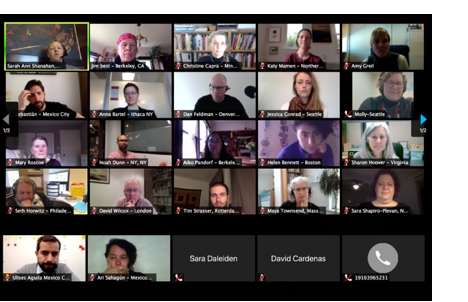
[ap_spacing spacing_height="20px"]
Purpose and Needs
Both the mapping efforts and the virtual cafe identified the needs in the community. Both groups found similar themes and purposes, which cover:
- To help the community discover its identities, building trust-based relationships, and encouraging/facilitating collaborations and learning.
- To further build the field of network weaving, understand its potential and role in systemic change.
- To deepen information flows, to connect related capacities and to attract more abundance to our work.
[ap_spacing spacing_height="10px"]
What has been happening
The network mapping journey
The journey to create a useful network map is highly participative and members of the network weavers facebook group are encouraged to join in any step of the process that is the right fit for them. There are three distinct phases that we are working through; First, we are taking the time to envision and get a better sense of what the community wants, needs and values. Once we have that clarity we’ll move into a technical phase where we’ll build the map. Finally, we’ll work together to make sense of what we are seeing in that map. We kicked off the envisioning phase with twenty seven members of the Facebook group in a zoom session with the larger group having been invited to contribute their perspective in a survey.[ap_spacing spacing_height="10px"]
The Master Mappers have extensive experience with network mapping. Christine Capra, Sarah Ann Shanahan, Maya Townsend, Lisa Negstad, Jim Best and Drew Mackie serve with their efforts and knowledge to facilitate learning, increase the awareness regarding passions and relationships within our community, and to develop the mapping skills of network weavers. This is the process of the mapping and as you see you can work closer with the Master Mappers, fill in surveys and attend the convenings.
[ap_spacing spacing_height="10px"]
Next Meeting on the 2nd April 9:00 -10:30 a.m. CT
Register at:
https://zoom.us/meeting/register/3e12488a815da90c8c34be5db4a05ad8
[ap_spacing spacing_height="20px"]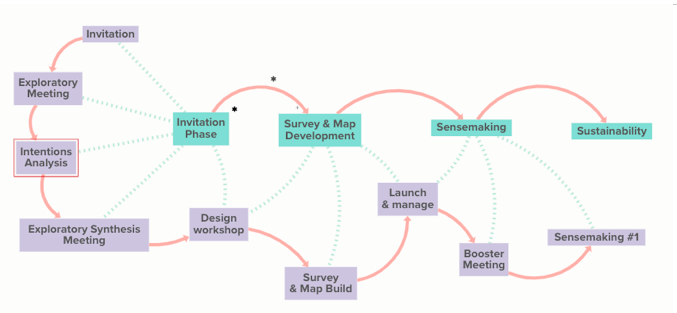
[ap_spacing spacing_height="20px"]
The Virtual Cafes, hosted by an open group of facilitators each month, aim to intensify learning, peer assistance and our service to systemic changes. There have been two cafes so far and the next one is coming up at the 4th of April. The hosts are currently Tim Strasser, Nenad Maljković, Ben Roberts, Jim Best, Keala Young and Adrian Röbke. The hosting group is open. Whomever wants to contribute is very welcome! In the last cafe on the 7th of March we explored our learning wishes and already dove into some of them in an open space, which is one of the many interactive formats we will use to have fun. These wishes to which you can add anytime are a basis for further explorations and journeys.
[ap_spacing spacing_height="20px"]
Event Link: https://www.facebook.com/events/248389826079525/?event_time_id=248389829412858
So this is about it. Personally, I feel lots of excitement and curiosity about what we can co-create as a global community. After just three gatherings I have made lots of good connections and I am sure that really cool ideas will emerge when we get together! Looking forward to seeing and hearing you soon!
[ap_spacing spacing_height="10px"]
Adrian Röbke
[ap_spacing spacing_height="20px"]
Photo by Kyle Glenn on Unsplash
Network Weaving
Network weaving plays a critical role in community development strategies of all kinds. In the Connected Community Approach, networks of residents, organizations and institutions are central to creating place-based systems change.
In this video local community builders share their stories, skills and insights as they explore the tremendous impact network weaving can have on the health and vitality of community.
For more examples of the Connected Community Approach in action, please visit www.thestorefront.org
For more tools and ideas on how to create your own connected community, please visit www.connectedcommunities.ca

Money Patterns Matter
Join us for an interactive workshop with Michael Linton about circular systems for circular economies. There is more talk of the circular economy than there is action, and will be until circular moneys makes material and service circulation possible and viable. But, too few yet have any idea what circular money actually is, and less still know how easy it can be to implement.
This is an opportunity to begin a process of participative enquiry, to discover how to apply common money to open cooperative ventures so that they can pay their own way.
[ap_spacing spacing_height="15px"]
February 21, 2019 18:00 UTC Event time in YOUR time zone HERE
Hosted by Nenad Maljković and Michael Linton
[ap_spacing spacing_height="20px"]
Start NOW: take time in advance of our workshop to check out notes shared by the presenter
Video conference joining instructions will be shared vie email ONE HOUR BEFORE the event. Contributors to REconomy practitioners Open Collective have FREE access to all our events.
This event is organized within REconomy practitioners local-to-global virtual community of practice. Click here for more information about what we are up to.
[ap_spacing spacing_height="20px"]



